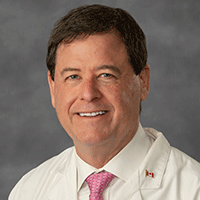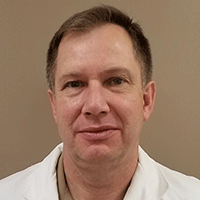
Thursday, November 4, 2021, 11:20AM - 12:05PM
Name: Bruce Rubin
Presentation Title: Effective Aerosol Therapy in Children and Novel Devices
Abstract: Aerosol therapy is a mainstay for the treatment of airway diseases. Medication delivered by aerosols is generally less expensive, works more rapidly, and produces fewer side effects in the same medications delivered systemically. As well medications can often be delivered to the airways that would otherwise be rendered ineffective if given systemically.
The requirements for aerosol therapy depend greatly on the target site of action and the underlying disease. Asthma medications should deposit on the conducting airways while peptides intended for systemic absorption would require deposition at the alveolar capillary bed. Examples of the latter include insulin for the treatment of diabetes and inhaled growth hormone (1). Effective deposition requires ultrafine particles to allow them to penetrate to the deep lung, a slow inhalation, and relatively normal airways that do not hinder aerosol penetration. Furthermore, the forces needed to generate the aerosol should not degrade these proteins.
Classically, aerosol bronchodilators and inhaled corticosteroids (ICS) are used to treat asthma. Effective deposition requires particle size and inspiratory flow appropriate for airway deposition with sufficient resident time in the airway to allow sedimentation. Generally, this means high efficiency production of particles between 0.5-5 µm mass median aerodynamic diameter (MMAD) inhaled with a slow inspiratory flow and a breath hold. Many devices have been developed to facilitate effective inhalation. Some common reasons for therapeutic failure of these aerosol medications include the use of inactive or depleted medications, inappropriate use of the aerosol device, and poor adherence to prescribed therapy (2, 3).
There are additional challenges when aerosol medications are used in infants and small children (4), or during an acute asthma attack. Rapid respiratory rate and patient anxiety lead to depositing more drug in the oral pharynx and less in the airways. Airway obstruction and inhomogeneous ventilation may also limit the targeted deposition of medications. Although all of the commonly used aerosol devices (jet nebulizers, pressurized metered dose inhalers, and dry powder inhalers) have been shown to be equally effective when used correctly the ability to use these during an acute asthma exacerbation may be compromised.
These challenges are even greater when the patient is in respiratory failure on a mechanical ventilator. Depending on humidification within the ventilator circuit and the ventilator duty cycle there may not be adequate time for the aerosol cloud to develop in the circuit and the geometry of the circuit may hinder the deposition of the aerosols in the airway (5).
Other medications that have been used for the treatment of airway disease include mucolytics such as dornase alfa used to treat cystic fibrosis (CF) and aerosolized antibiotics such as tobramycin solution. Pulmonary deposition of these medications can be severely compromised when the airway is filled with pus. Both dornase and aerosol antibiotics are unlikely to penetrate to the deep lung despite good devices (6). It is possible that the use of surfactants as a carrier or as a therapeutic agent may help to clear the airways and to transport medication such as these into the deeper lung.
This challenge is even greater when delivering gene therapy vectors to the airway. These are very large molecules often unstable to nebulization, requiring precise dosing, and administered to patients with lung disease. Nevertheless, techniques are being developed to improve the deposition of these vectors in the lungs particularly of patients with CF (7).
The nasal passage is an additional target for drug therapy. Pump inhalers have been used to administer decongestions or corticosteroids to the nose but deposition into the sinuses is poor. Because of the importance of sinus deposition of antibiotics and other medications for the treatment of chronic sinusitis there is active investigation not only into developing devices for nasal inhalation but also mechanisms (such as humming after inhalation) that may help to deposit medications within the nose and sinuses (8).
Despite the mechanical and engineering challenges in designing devices for aerosol administration, the clinician's greatest challenge is patient education to use their medications and aerosol devices appropriately (3).
Bio: Bruce Rubin is the Jessie Ball duPont Distinguished Professor of Pediatrics at Virginia Commonwealth University, and was Chair of Pediatrics and Physician in Chief of the Children’s Hospital of Richmond from 2009-2020. He is also Professor of Biomedical Engineering and affiliate Professor of Physiology and Biophysics at VCU. As a Rhodes Scholar, he trained in Biomedical Engineering at Oxford University and then did his fellowship in Paediatric Respirology at Sick Kids in Toronto. He holds the MD and Masters in Engineering degrees from Tulane, and an MBA degree from Wake Forest University Babcock School of Business. He, the International Congress of Pediatric Pulmonology (CIPP), and the American Respiratory Care Foundation, and he is Medical Advisor to the Virginia Society of Respiratory Care. He is a fellow of the AAP, elected to the APS, and a Fellow of the Royal College of Physicians and Surgeons of Canada.
Dr. Rubin received the Forest Bird Lifetime Scientific Achievement Award and the Jimmy A Young Medal from the AARC, the Prix extraordinaire from CIPP and he is a Prix Galien Laurate. He holds honorary appointments in four medical schools, is on the editorial board of 10 journals, has published more than 300 original research papers ((H-index 68) and chapters, and holds 10 patents. His research focus is regulation of mucus clearance in health and disease, airway inflammation and immunomodulation, cough, and aerosol delivery of medications.
Dr. Rubin is also a magician, elected to membership in the International Brotherhood of Magicians (Wizard Award) and over the past 25 years has taught medical magic in 40 countries on 5 continents.

Wednesday, November 3, 2021, 11:50AM - 12:35PM
Name: Josh Duckworth
Presentation Title: Monitoring of Sub concussive Blast Overpressure Exposure in Military Personnel - Sensors, Variables, and Physiologic Associations
Abstract: The long-term effects of repeated sub-concussive blast exposures (RSCBE) are unknown. Evaluation of blast exposures in deployed settings during Operation Enduring Freedom demonstrated that 2/3 of all recorded blast exposure among service members occurred during training. The COmbat and traiNing QUeryable Exposure/event Repository (CONQUER) operational monitoring program has collected individual-level blast exposure data during 185 combat training cycles/events among service members representing the U.S. Army, Navy, Marine Corps and Air Force, including both Special Operations and Conventional Forces, as well as National Guard units. CONQUER is designed to capture, quantify and report blast overpressure events experienced by service members to command leadership at multiple levels. CONQUER currently employs the Black Box Biometrics (B3) Generation 7 Blast Gauge System, which consists of three separate recording devices mounted on the head, shoulder and chest of service members collects quantified blast exposure data such as peak overpressure, peak overpressure impulse, number of exposures, and date/time of exposure for a subject during routine combat training operations. When a gauge is triggered above a settable threshold, a 20 ms recording of pressure vs. time is created, which can be examined and analyzed. Historically, the analysis of these data has been a labor intensive and time-consuming effort that required a blast expert to review overpressure versus time waveforms to identify recordings that may not have represented actual blast recordings. In these cases, each analyst would manually create graphics to summarize the data. However, this process and the parameters used to define real vs. potentially errant recordings have differed across analysts and groups. We have developed and are testing a standardized automated approach to process these data substantially that reduces manpower requirements. CONQUER data processed using the software that automatically identifies errant blast overpressure recordings has significantly reduced the manpower needed to analyze data. Using these standardized automated methods enables much more rapid creation of reports of blast exposure history for a unit. To date, approximately 6,000 gauge sets have been issued, more than 300,000 blast gauge recordings have been captured and over 150,000 full waveforms have been processed. Over 185 unit level and personnel level reports have been created and delivered to commanders since 2018.
Service members involved in heavy weapons training (HWT) courses or exercises will be exposed to repetitive sub-concussive blast exposure events (RSCBE). Instructors at heavy weapons training (HWT) schools may experience high number of HWT-associated blast exposures per year during a 2-3 years of assignments. Over the last decade, the operational, research, and medical communities have become increasingly aware that repetitive sub-concussive blast exposure (RSCBE) may cause acute, cumulative, and long-term clinical and physiologic effects. Service members involved in certain routine combat training courses or exercises will be exposed to multiple, primarily sub-concussive, blast overpressure events. RSCBE has historically been associated with clinical signs such as a decrease in neurocognitive function and subjective symptoms that are similar to those of post-concussive syndrome (headache, memory loss, changes in mood, inability to sleep, balance problems) but the long-term effects are largely unknown.
We have hypothesized that RSCBE causes lasting molecular level damages in the brain. INVestigating the neurologic effects of Training Associated Blast (I-TAB), monitored service members undergoing HWT with shoulder-fired recoilless weapons using serum based proteomic evaluations. Blood samples were collected from Students (n=6) and Instructors (n=10) at baseline, 6hrs, 24hrs, 72hrs, 2 weeks, and 3 months after HWT. Serum samples were isolated on site, aliquots were snap frozen, and shipped frozen for proteomics analysis. Serum samples were analyzed by using the reverse phase protein microarray (RPPM), a high sensitivity, high throughput proteomics platform to determine the serum levels of: ubiquitin carboxyl-terminal hydrolase L1 (UCH-L1), glial fibrillary acidic protein (GFAP), Claudin 5 (CLDN5), occluding (OCL), membrane metalloprotease 9 (MMP9), interleukin 6 (IL-6) and cholinergic receptor nicotinic alpha 7 subunit (CHRNA7) RPPM analyses were performed according to established procedures. Compared to the serum levels obtained before HWT, serum levels of all biomarkers were elevated following HWT both in the Instructor Group and in the Student Group; serum biomarker levels of all protein biomarkers tested were significantly higher in Instructors than in Students; serum levels of most of the tested protein biomarkers were the highest at 3 months post-training in the Student Group; autoantibody titers of proteins related to vascular and neuroglia-specific proteins were elevated in Students at 3 month after HWT as compared to the baseline levels. Our preliminary results from our pilot study indicates suggest that HWT may be associated with vascular and neuroglia insult and inflammation lasting for at least 3 months following exposures, based upon or observation of and results in elevated titers of autoantibodies against vascular and neuroglia specific proteins over time.
Bio: Professor of Neurology at the F. Edward Hebert School of Medicine at the Uniformed Services University of the Health Sciences (USUHS) where his research efforts are focused towards the understanding and management of traumatic brain injury related pathophysiology. He is currently conducting two clinical trials evaluating the neurologic effects of repetitive blast exposure and participating in a multicenter trial evaluating the effect of repetitive head impact in collegiate sports. He oversees a laboratory and translational TBI program targeting the molecular and cellular responses associated with sub-clinical and concussive forces, to include alterations in the neuronal membrane such as, the scaffolding protein Caveolin-1 and its role in membrane/lipid raft (MLR) formation and localization and Integrin activation and the relationship to cell adhesion and migration, the extracellular matrix (ECM), and mechano-transduction. Dr Duckworth has in-vitro and in-vivo models of both blast and impact which allow for translation and investigation of the primary and secondary response to these external forces. His medical training as Staff Neurologist/Neurointensivist and his research experience make him well qualified to perform investigator responsibilities in this study. He has been involved in numerous peer-reviewed publications that addressed traumatic brain injury and neurological disorders.